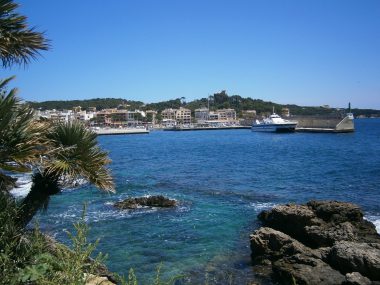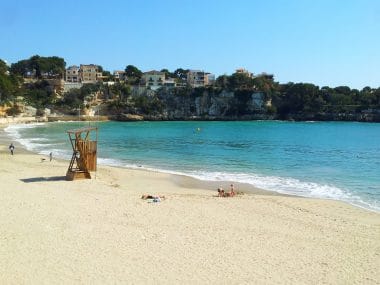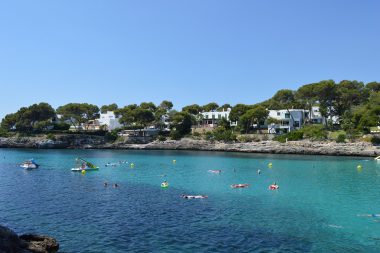Narrow bays and lonely beaches, a paradise for water sports enthusiasts
The southeast of Mallorca is undoubtedly the most graceful region of the island. A magical holiday route connects beaches and picture-book harbours with impressive caves. The coast with its turquoise blue sea, white sandy beaches lined with pine trees and whitewashed houses forms the cheerful side of Mallorca.
If there weren’t too many holidaymakers on the road in the high summer months, this region could best fulfil the dream of a Mediterranean idyll. The east coast differs significantly from the wildly romantic west/northwest.
Longer sandy beaches are mainly found in the northern area. The range of holiday resorts ranges from the quiet fishing port to the turbulent tourist centre. Great bathing opportunities, cave adventures and wide views lure on the east coast. If you are looking for peace and quiet, you will be happy in the south of the island. In a private finca, the southeast of Mallorca can be enjoyed away from the hustle and bustle. Popular destinations are the stalactite caves of Artá and Porto Cristo.
In the east of the island from north to south – between Cala Ratjada and Santanyi
Summer, sun, salt and wonderful water – the eastern coast of Mallorca is cheerful and gentle. The region has its very own charm, which is based in particular on the rural hinterland and the varied shoreline. The further south you go, the drier the wide and flat land becomes. Here, where the island is particularly hot, it looks almost Caribbean – pine green, salt mountain white and sea turquoise.
Fortunately, the fjord-like, deeply cut, picturesque bays invite you to take a refreshing dip in the turquoise sea. Longer beaches as well as expansive villa and apartment complexes can only be found in the north. In the far south, one searches in vain for bed castles or hotel bunkers. Parallel to the coastline runs the mountain range of the Serra de Llevant in the hinterland and forms a picturesque backdrop.
The light, peaceful landscape is lined with orchards, olive groves and almond trees. Smaller and larger holiday resorts are lined up here one after the other.
Cala Ratjada

Welcome to the Bay of Rays, where Mallorca and Menorca are particularly close. The large holiday resort impresses with a beautiful waterfront. At the idyllic harbour of Cala Ratjada , numerous fishing boats bob along. At the same time, the town attracts visitors with the enchanting Ray Bay, which consists of a whole series of rock-lined “calas”. If you like, you can take a coastal hike to the lighthouse. On clear days, visitors are rewarded with magnificent views of Menorca.
Cala Millor / Cala Bona
Cala Millor and Cala Bona have grown together to form one of the largest tourist centres in the east. While the beautiful, albeit completely built-up, promenade invites you to stroll, bathers and water sports enthusiasts enjoy the three-kilometre-long fine sandy beach. The predominantly four-star hotels are firmly in the hands of German tour operators. Holidays, summer, sun, sand – life can be enjoyed on Millor beach.
Porto Cristo

Porto Cristo offers a welcome change from the often sterile holiday centres. Porto Cristo is less important as a holiday resort, but the stalactite caves Coves del Drac and Coves del Hams are a very special attraction of the small town. In a virtual Jules Verne show, you can emulate the larger dragon caves at the small underground lake. There is no guided tour of the dragon’s cave, everything is left to the imagination. Tip: The caves are always well visited. A visit is recommended in the early morning hours.
Felanitx, Campos and Manacor
Felanitx, Campos and Manacor are the towns worth seeing a little off the coast.
In Arab times, Felanitx was a stronghold of the production of blue tiles. Today’s ceramic workshops can be regarded as a late legacy. The small town founded by the Moors stretches over four hills. 25 well-preserved, former windmill towers tower over the pretty holiday resort.
Half an hour from Palma , the charming farming town of Campos offers itself. With its dead straight streets, the island’s agricultural stronghold seems a little sleepy, but on market days on Thursdays and Saturdays, Campos also gets livelier. Manacor is the third largest island municipality and receives little attention in many travel guides. Wrongly, because the city centre with its pretty cafés and bars looks extremely authentic. A visit to the “Rafa Nadal” sports centre is particularly popular.
Portocolom
Portocolom – the port of Columbus – was first mentioned in the 13th century. Supposedly, the famous sailor was born here. Italy and Spain are still arguing about the actual “uncertain” place of birth. One thing is certain: Once upon a time, the wines pressed in Felanitx were shipped from here. In addition, guests enjoy a wonderful harbour idyll.
Cala D’or

Cala D’or is one of the oldest resorts on the island. The small town of 4000 inhabitants inspires with its flat, whitewashed villas. Between the flower-covered houses, small pine groves set green sprinkles. Despite its perfect infrastructure, the town has retained a great deal of serenity. Shops, pretty boutiques and inviting restaurants are grouped around the harbour. Cala D’or is also ideal for emigrating to Mallorca. The best properties in Cala Dor are of course close to the beach.
Lonely end of the island in the southeast of Mallorca: Where the island says goodbye to the sea – between Ses Salines and Santanyí
Cap de ses Salines forms the southernmost point of Mallorca. Kilometre after kilometre, the car rocks past fields of olive and carob trees. The Far des Cap de ses Salines towers above it all. The red and white face of the lighthouse has an almost meditative effect. The sea is not to be seen, but you still feel: it can’t go any further here – a magical place.
Santanyí
Santanyí, in the silence of the southeast, forms the liveliest part of the island. In recent years, the town has developed into a small visitor magnet with its numerous cafés, bars, restaurants and boutiques. Not far from the tranquil small town are beautiful sandy beaches. Maybe the other side of paradise?
Cala S’Almunia near Santanyí is the neighbouring bay of Cala des Moro and invites you to swim and snorkel in a magical setting.
Es Trenc
Es Trenc with a seven-kilometre-long Robinsonade of bright white dunes and turquoise sea is considered Mallorca’s dream beach.
If you can’t get enough, visit Cala Pi, which stretches into the sea like a fjord west of Ses Salines. Cala Pi is a true beach beauty with crystal clear waters.
Once you arrive in the south of the island, you want to float forever through the lonely landscapes. Here Mallorca is still a bit like it might have once been.
Mallorca, Part 1: Palma and the southwest coast
Mallorca, Part 2: In the northwest of Mallorca
Mallorca, Part 3: The North of Mallorca
Mallorca, Part 5: The centre of the island
Können wir Ihnen helfen?
Benötigen Sie Unterstützung bei Ihrer Reiseplanung oder weitergehende Informationen zu einzelnen Reisezielen? Wir freuen uns über Ihre Kontaktaufnahme.


